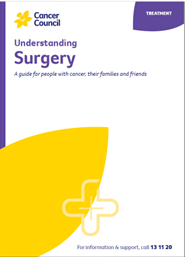Surgery for early kidney cancer
Surgery is the main treatment for early kidney cancer. Depending on the type of kidney cancer, the grade and stage of the cancer, and your general health, you might have surgery to remove part or all of a kidney.
Learn more about:
- Partial nephrectomy (removing part of the kidney)
- Radical nephrectomy (removing the whole kidney)
- The remaining kidney
- How the surgery is done
- Making decisions about surgery
- What to expect after surgery
Partial nephrectomy (removing part of the kidney)
This removes the cancer and a small part of the surrounding tissue, leaving some healthy tissue in the affected kidney. This operation may be recommended for tumours smaller than 7 cm that are in the kidney only. It may also be used for people who have existing kidney disease, cancer in both kidneys, or only one working kidney.
A partial nephrectomy is a more complex operation than a radical nephrectomy. Whether it is possible depends on where the tumour is in the kidney, as well as the expertise of the surgeon and hospital.

Radical nephrectomy (removing the whole kidney)
The whole affected kidney, a small part of the ureter and the surrounding fatty tissue are removed. The adrenal gland and nearby lymph nodes might also be removed. This is the most common operation for large tumours.
Sometimes the kidney cancer may have spread into the renal vein and even into the vena cava, the large vein that takes blood to the heart. Even if the cancer has spread to the vena cava, it is sometimes possible to remove all the cancer in one operation.

The remaining kidney
If a whole kidney or part of a kidney is removed, the remaining kidney usually does the work of both kidneys. Your doctor will talk to you about how to keep the remaining kidney healthy, which may include taking steps to reduce your risk of high blood pressure, heart problems and diabetes.
How the surgery is done
If you have surgery for kidney cancer, it will be carried out in hospital. A nephrectomy is a major operation and you will be given drugs (general anaesthetic) to put you to sleep and temporarily block any pain or discomfort during the surgery.
One of the following methods will be used to remove part or all of the kidney (partial or radical nephrectomy). The method recommended for you will depend on the size and location of the tumour and your general health. Your surgeon will talk to you about the risks of the procedure.
Open surgery
- This is usually done with a long cut (incision) at the side of your abdomen where the affected kidney is located.
- In some cases, the incision is made in the front of the abdomen or in another area of the body where the cancer has spread.
- If you are having a radical nephrectomy, the surgeon will clamp off and divide the major blood vessels and tubes to the affected kidney before removing it.
Keyhole surgery
- This is also called minimally invasive surgery or laparoscopic surgery.
- The surgeon will make a few small cuts in the skin, then insert a tiny instrument with a light and camera (laparoscope) into one of the cuts.
- The surgeon inserts tools into the other cuts to remove the cancerous tissue or kidney, using images from the camera as a guide.
Robot-assisted surgery
- This is a type of keyhole surgery performed with help from a robotic system.
- The surgeon sits at a control panel to see a 3-dimensional picture and moves robotic arms that hold the instruments.
- Robotic surgery has meant that more partial nephrectomies can be performed with keyhole surgery, reducing complications and improving recovery time.
Making decisions about surgery
Talk to your surgeon about the types of surgery suitable for you. Ask about the advantages and disadvantages of each method. There may be extra costs involved for some procedures and they are not all available at every hospital.
Compared to open surgery, both keyhole (laparoscopic) surgery and robot-assisted surgery usually mean a shorter hospital stay, less pain and a faster recovery time. But in some cases, open surgery may be a better option.
See our general section on Surgery for more information about surgery and recovery.
→ READ MORE: What to expect after surgery for kidney cancer
Podcast: Making Treatment Decisions
Listen to more episodes from our podcast for people affected by cancer
More resources
Dr Alarick Picardo, Urologist, Fiona Stanley Hospital, WA (clinical review); Heidi Castleden, Consumer; Donna Clifford, Urology Nurse Practitioner, Royal Adelaide Hospital, SA; Prof Paul De Souza, Medical Oncologist and Professor of Medicine, Nepean Cancer Care Centre, The University of Sydney, NSW; Mike Kingsley, Consumer; Prof Declan Murphy, Urologist and Director of Genitourinary Oncology, Peter MacCallum Cancer Centre, VIC; Caitriona Nienaber, 13 11 20 Consultant, Cancer Council WA; Luke O’Connor, Urology Nurse, Royal Brisbane and Women’s Hospital, QLD; A/Prof Shankar Siva, Radiation Oncologist and Cancer Council Victoria Colebatch Fellow, Peter MacCallum Cancer Centre, VIC; A/Prof Homi Zargar, Uro-Oncologist and Robotic Surgeon, Western Health and Royal Melbourne Hospital, VIC.
View the Cancer Council NSW editorial policy.
View all publications or call 13 11 20 for free printed copies.

